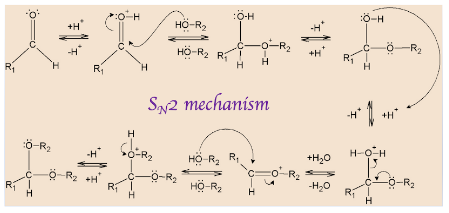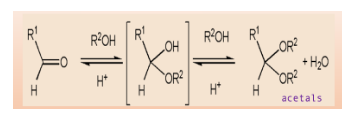
What are acetals and hemiacetals?
Answer
497.4k+ views
Hint: An acetal forms when two ether groups are attached to the same carbon. It is also prepared from a hemiacetal, which is derived from an aldehyde that contain one ether group and one alcohol group.
Complete step-by-step answer:
When aldehyde and ketones react with alcohols under an acidic environment, they form acetals. These are functional groups with tetrahedral geometry, in which two alkoxy
The mechanism starts with protonation of carbonyl oxygen that makes
Hemiacetal has only one alkoxy group compared to acetals which has two alkoxy groups. Further, the OH group of hemiacetal is protonated and changed into a good leaving group. As carbon becomes sterically hindered,
Therefore,

Hemiacetals are formed from an aldehyde or ketone and an alcohol, by forming an ether bond and OH bond on the same carbon. It is a tetrahedral intermediate in the formation of acetal. When it is catalysed by an acid, it becomes faster but acid can proceed it to decomposition also, back to the starting material.

Note: A hemiacetal structure acts as a reducing sugar and thus it is unstable in nature. On the contrary, acetals are non-reducing sugars and are stable as they are not converted back into aldehyde or hemiacetals.
Complete step-by-step answer:
When aldehyde and ketones react with alcohols under an acidic environment, they form acetals. These are functional groups with tetrahedral geometry, in which two alkoxy
The mechanism starts with protonation of carbonyl oxygen that makes
Hemiacetal has only one alkoxy group compared to acetals which has two alkoxy groups. Further, the OH group of hemiacetal is protonated and changed into a good leaving group. As carbon becomes sterically hindered,
Therefore,

Hemiacetals are formed from an aldehyde or ketone and an alcohol, by forming an ether bond and OH bond on the same carbon. It is a tetrahedral intermediate in the formation of acetal. When it is catalysed by an acid, it becomes faster but acid can proceed it to decomposition also, back to the starting material.

Note: A hemiacetal structure acts as a reducing sugar and thus it is unstable in nature. On the contrary, acetals are non-reducing sugars and are stable as they are not converted back into aldehyde or hemiacetals.
Latest Vedantu courses for you
Grade 11 Science PCM | CBSE | SCHOOL | English
CBSE (2025-26)
School Full course for CBSE students
₹41,848 per year
Recently Updated Pages
Master Class 4 Maths: Engaging Questions & Answers for Success

Master Class 4 English: Engaging Questions & Answers for Success

Master Class 4 Science: Engaging Questions & Answers for Success

Class 4 Question and Answer - Your Ultimate Solutions Guide

Master Class 11 Economics: Engaging Questions & Answers for Success

Master Class 11 Business Studies: Engaging Questions & Answers for Success

Trending doubts
Give 10 examples of unisexual and bisexual flowers

Draw a labelled sketch of the human eye class 12 physics CBSE

a Tabulate the differences in the characteristics of class 12 chemistry CBSE

Differentiate between homogeneous and heterogeneous class 12 chemistry CBSE

Why is the cell called the structural and functional class 12 biology CBSE

Differentiate between insitu conservation and exsitu class 12 biology CBSE




